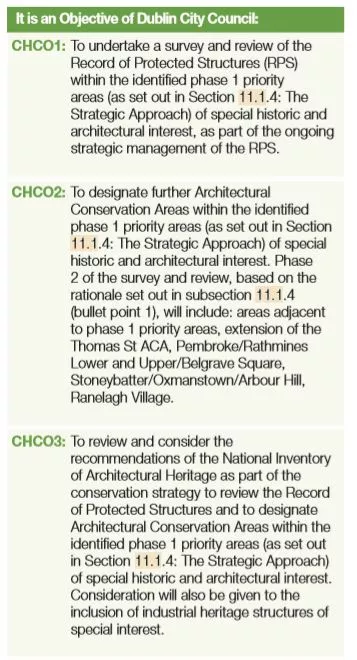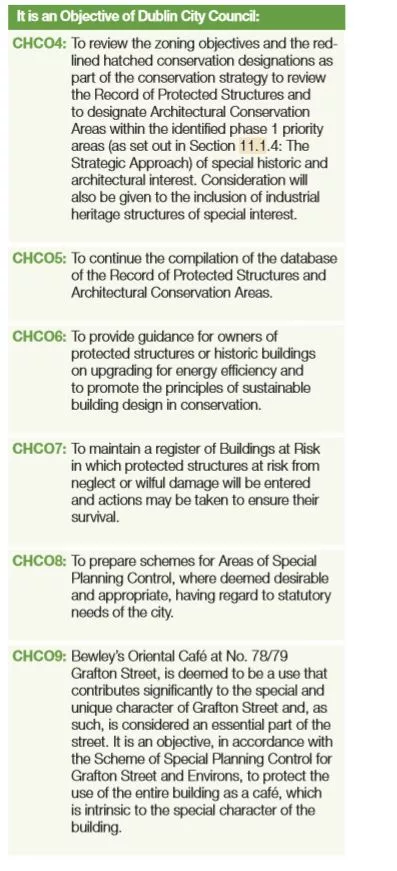11.1.5.6 Conservation Area – Policy Application
11.1.5.6 Conservation Area – Policy Application
Conservation Area – Policy Application
All new development must have regard to the local context and distinctiveness and the contribution to the local scene of buildings, landmarks, views, open spaces and other features of architectural, historic or topographical interest. The general design principles are set out in a separate policy but it is particularly important within Conservation Areas that design is appropriate to the context and based on an understanding of Dublin’s distinctive character areas.
Dublin has an outstanding range of Conservation Areas with examples of built form from each of the phases of the city’s development: this includes areas of 18th and 19th century terraced housing, modest mews and workers’ housing, 20th century housing and areas dominated by governmental and institutional uses and more mixed central areas such as O’Connell Street and Grafton Street. Detailed characterisation of individual areas to inform development proposals has and is being undertaken in Architectural Conservation Area appraisals and these will be a key consideration when assessing development proposals in Architectural Conservation Areas.
New development should have a positive impact on local character. In seeking exemplary design standards, the planning authority will require development in Conservation Areas to take opportunities to enhance the area where they arise. Where a building has been identified as having a negative impact on an area, a pro-active approach to improvement will be sought. Where proposals involve demolition, policy for demolition of protected structures and buildings in architectural Conservation Areas should be referred to.
Where the carrying out of works to the exterior of a structure, including small-scale alterations, which would not usually require planning permission, but are identified in Architectural Conservation Area appraisals as materially affecting the character of an area, then these works may no longer be considered to be exempt from planning permission. Examples may include the protection of historic doors and windows in an unaltered group of residential buildings, alterations to brickwork and pointing.
To ensure that no advertising material other than brass, stone, stainless steel signs or other suitable quality material will be permitted in residential Conservation Areas. On commercial properties leading into such areas, advertising will be severely restricted, and shall only relate to the service provided in the premises.
It is not only visual elements that contribute to the character of a Conservation Area, land-uses and activities are fundamental to the character and appearance of Dublin’s Conservation Areas. Certain uses are of historic importance to specific areas and some are of national or international importance; these have influenced the evolution and built form within the area and may continue to have a strong effect on its character at present.
Different users of buildings and spaces also change and shape their character over time and some conservation areas are strongly influenced by the communities which occupy them. In considering applications for change of use, the contribution of particular uses to the character of areas needs to be considered, the value that the local community places on particular buildings or uses is also important.
Development outside Conservation Areas can also have an impact on their setting. Where development affects the setting of a Conservation Area, an assessment of its impact on the character and appearance of the area will be required. It should be recognised that this setting can be expansive and development located some distance away can have an impact. Any development which adversely affects the setting of a Conservation Area will be refused planning permission and the City Council will encourage change which enhances the setting of Conservation Areas.

